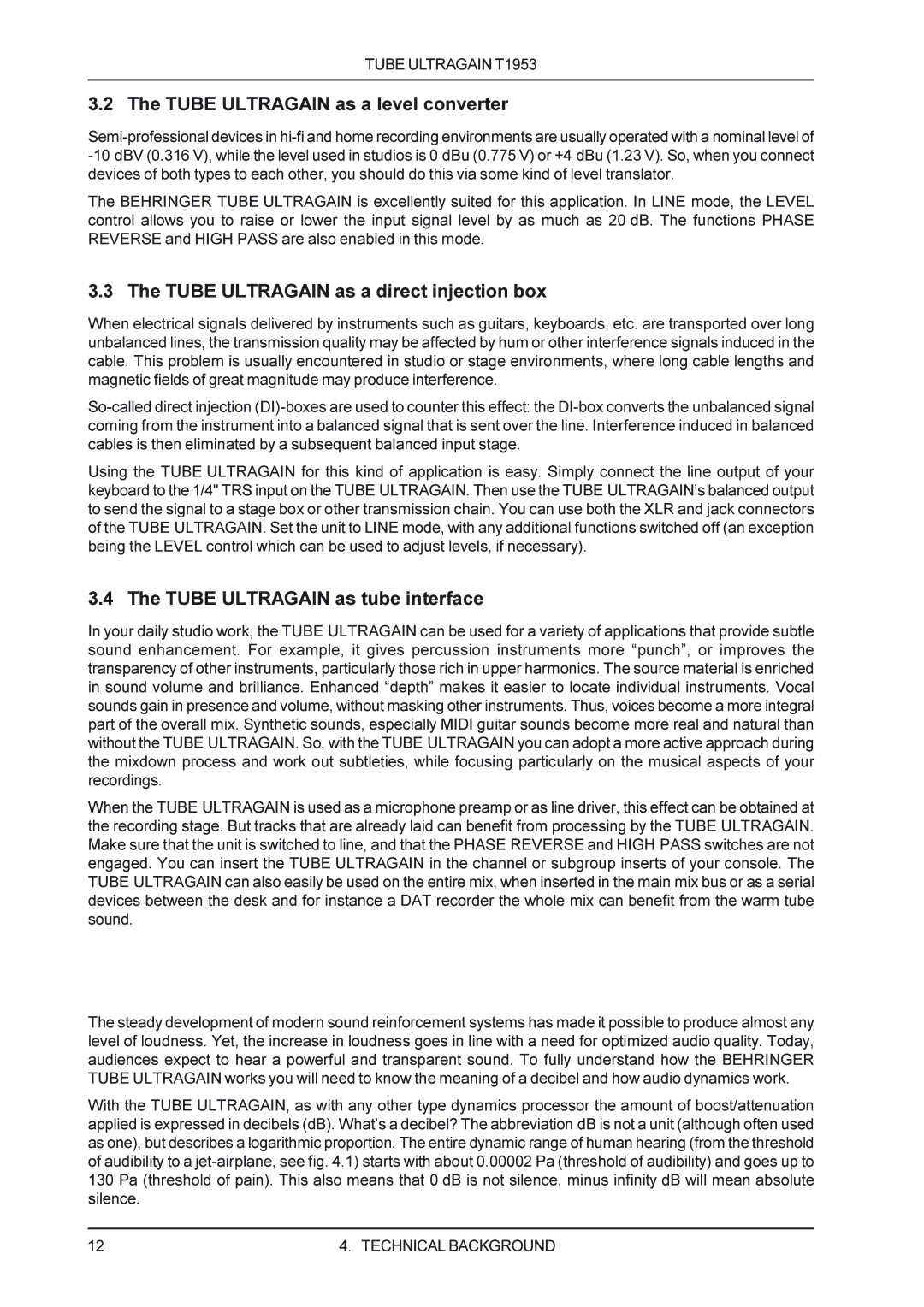
TUBE ULTRAGAIN T1953
3.2 The TUBE ULTRAGAIN as a level converter
The BEHRINGER TUBE ULTRAGAIN is excellently suited for this application. In LINE mode, the LEVEL control allows you to raise or lower the input signal level by as much as 20 dB. The functions PHASE REVERSE and HIGH PASS are also enabled in this mode.
3.3 The TUBE ULTRAGAIN as a direct injection box
When electrical signals delivered by instruments such as guitars, keyboards, etc. are transported over long unbalanced lines, the transmission quality may be affected by hum or other interference signals induced in the cable. This problem is usually encountered in studio or stage environments, where long cable lengths and magnetic fields of great magnitude may produce interference.
Using the TUBE ULTRAGAIN for this kind of application is easy. Simply connect the line output of your keyboard to the 1/4" TRS input on the TUBE ULTRAGAIN. Then use the TUBE ULTRAGAIN’s balanced output to send the signal to a stage box or other transmission chain. You can use both the XLR and jack connectors of the TUBE ULTRAGAIN. Set the unit to LINE mode, with any additional functions switched off (an exception being the LEVEL control which can be used to adjust levels, if necessary).
3.4 The TUBE ULTRAGAIN as tube interface
In your daily studio work, the TUBE ULTRAGAIN can be used for a variety of applications that provide subtle sound enhancement. For example, it gives percussion instruments more “punch”, or improves the transparency of other instruments, particularly those rich in upper harmonics. The source material is enriched in sound volume and brilliance. Enhanced “depth” makes it easier to locate individual instruments. Vocal sounds gain in presence and volume, without masking other instruments. Thus, voices become a more integral part of the overall mix. Synthetic sounds, especially MIDI guitar sounds become more real and natural than without the TUBE ULTRAGAIN. So, with the TUBE ULTRAGAIN you can adopt a more active approach during the mixdown process and work out subtleties, while focusing particularly on the musical aspects of your recordings.
When the TUBE ULTRAGAIN is used as a microphone preamp or as line driver, this effect can be obtained at the recording stage. But tracks that are already laid can benefit from processing by the TUBE ULTRAGAIN. Make sure that the unit is switched to line, and that the PHASE REVERSE and HIGH PASS switches are not engaged. You can insert the TUBE ULTRAGAIN in the channel or subgroup inserts of your console. The TUBE ULTRAGAIN can also easily be used on the entire mix, when inserted in the main mix bus or as a serial devices between the desk and for instance a DAT recorder the whole mix can benefit from the warm tube sound.
4. TECHNICAL BACKGROUND
The steady development of modern sound reinforcement systems has made it possible to produce almost any level of loudness. Yet, the increase in loudness goes in line with a need for optimized audio quality. Today, audiences expect to hear a powerful and transparent sound. To fully understand how the BEHRINGER TUBE ULTRAGAIN works you will need to know the meaning of a decibel and how audio dynamics work.
With the TUBE ULTRAGAIN, as with any other type dynamics processor the amount of boost/attenuation applied is expressed in decibels (dB). What’s a decibel? The abbreviation dB is not a unit (although often used as one), but describes a logarithmic proportion. The entire dynamic range of human hearing (from the threshold of audibility to a
12 | 4. TECHNICAL BACKGROUND |
